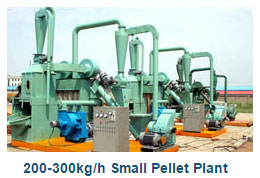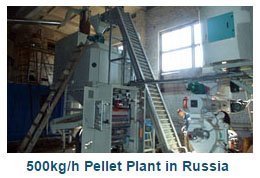Building of pellet plant promote the market development
According to a new report recently published by Transparency Market Research, the global wood pellets market is expected to expand at a 14.10% CAGR during the period from 2015 to 2023. The report, titled ‘Wood Pellets Market, by Application - Global Industry Analysis, Size, Share, Growth, Trends and Forecast 2015 - 2023’, states that the global wood pellets market was valued at US$6.2 bn in 2014 and is predicted to be valued at US$20 bn by 2023. Increase in use of wood pellets in power plants and heating plants will enable rapid development of the global wood pellets market during the forecast period.
Pellet plants are continuously developed under the great demand for clean pellet fuel all round the work, like in the UK, the untied states and Brazil etc. Some of the pellets are produced to meet the local people for room heating or for industrial use for power station. The others are built for exported to other places. Generally, the pellet plant was build at the place which is near to the feedstock for production, and has easy access to many kinds of delivery method, like rail, road and Ocean Shipping. It made the pellets can be exported to the place which need pellets. It also cut the money for transport.
Pellet plants are continuously developed under the great demand for clean pellet fuel all round the work, like in the UK, the untied states and Brazil etc. Some of the pellets are produced to meet the local people for room heating or for industrial use for power station. The others are built for exported to other places. Generally, the pellet plant was build at the place which is near to the feedstock for production, and has easy access to many kinds of delivery method, like rail, road and Ocean Shipping. It made the pellets can be exported to the place which need pellets. It also cut the money for transport.
As for the raw materials for pellet plant,different regions have different material according to different regional condition. The South Dakota pellet plant, sponsored by the earth partners LP, has acquired Deadwood Biofuels, a 71,000-ton wood pellet plant in Deadwood,South Dakota. The Deadwood plant utilizes pine beetle killed wood, forest residues, thinnings and low-grade timber sourced from South Dakota’s Black Hills, materials removed to improve forest health. While in Tance, the south of Brazil, the wood pellet plant use the vegetable tannin as the feedstock. Vegetable tannin, is a high value-added product mainly used by the leather industry, and in water and wastewater treatment. Tannin is extracted from the bark of Acacia mearnsii. After removing the bark, the remaining wood is chipped at Tanac's woodchip mill, a proportion of these woodchips are provided for the feedstock for the new pellet mill. For the wood pellet plant in British Columbia, the project is being developed by SMG wood pellet Inc., the feedstock for this plant is mainly fiber content. This is going to be a first-of-its kind facility in North America, it will features state-of-the-art technologies and best practices with regard to fiber handling and processing. Biomass feedstock will be processed as it is received, with the facility only having three to four days of feedstock on hand at a time.
The applying of these pellets is different either. The Hull’s new biomass fuel plant is for Drax power station. One million tomes of pellets will pass through the 164-ft(50m) tall silo at Hull’s King George Dock each year. The silo stores 1,800 tonnes of the fuel which will be loaded on to trains for delivery to Drax power station in Yorkshire. While in British Columbia, the SMG sponsored pellet plant, aims to produce wood pellets export in South Korea and other Asian market. The reason is that a political mandate in South Koreas to reduce carbon emissions came into effect this year and is scheduled to ramp up over the next 15 years. Demand for pellet in that market is significant. As for the Dakota pellet plant in the United States, the pellet plant would maintain a focus on serving local residential and industrial markets-exporting is not currently on the drawing board. In Brazil, the Tanac plant, the first pellet due for export in mid-2016. A long term agreement for the supply of wood pellets has been entered into with Drax power Ltd., that is to say, these pellets are being used for power generation. In the United States; the new Drax pellet plant is located approximately three miles from Calhoun Falls, a town on the western board of South Carolina. The location is near the feedstock of hard textile plant which shortened the distance for transport to the pellet plant. At the same time, the convenient transportation made it easy to delivery to the port. The property is broadened by a four line highway that complements its rail access. The CSX rail line provides efficient shipping of finished pellets that would transported to either the port of Savannah or the Port of Charleston giving this location a strategic advantage.
Building of big pellet plant creates jobs, directly and indirectly, within the forestry supply chain, forest management and industrial operations sectors. For the pellets used in the power station, it provides the clean energy for the power station and reduces the pollution of the air of carbon emission. Of course, it provides heat to people for home heating system.
From above, we can see that different country has different measures to deal with the high development of pellet demand. As the process of building more pellet plants, it can meet the demand of pellet fuel periodically. But from the long run, the market demand for pellet is still large all around the world. The big company which has strong production capacity and investment are easy to engage in this business, to earn more money in the market. Cooperation between different countries and business companies is more and more frequently, it promotes the development of biomass pellet fuel. As the advancement of pellet technology, the market is more mature in the future.
In conclusion, wood pellets, or biomass pellets, coming roaring onto the international market in recent decade years, are highly recognized by more and more countries around the world. Europe and North America have made a big step in both pellets production and consumption as important contribution to energy conservation.
-----------------------------------------------------------------------------------------------------------------------------------------------
In conclusion, wood pellets, or biomass pellets, coming roaring onto the international market in recent decade years, are highly recognized by more and more countries around the world. Europe and North America have made a big step in both pellets production and consumption as important contribution to energy conservation.
-----------------------------------------------------------------------------------------------------------------------------------------------
How to start a pellet plant is usually raised by clients or potential clients who possess abundant and sufficient biomass material such as wood blocks, wood sawdust or saw shavings, bark, tree branches and twigs as well as rice husk, wheat straw, cotton stalks, maize stalks, corn cobs, bagasse, palm EFB, bamboo.
News
- Small Pellet Machine Manufacturer-Kingman
- Application of Wood Pellets and Use of Biomass Pellets
- From Fossil Fuel into Biomass Pellet Fuel
- Biomass Pellet Making Machines Market
- Applying of pellet stoves for home use
- Highland pellets to build $130 million facility in arkansas
- How to deal with the blocked hammer mill
- How to Make Wood Pellets with Sawdust
- The government policy promotes the development of biomass fuel
- Market analysis of biomass pellet fuel
- Strategic positioning of renewable energy
- Biomass energy has pass through the pre assessment
- The key point of deep processing of biomass pellet
- Harbin is promoting the development of biomass machinery
- The development of biomass formation technology I
- The development of biomass formation technology II
- Biomass energy industry is now going full tilt in 2015
- Rapid increasing demand of sawdust pellet on the market
- Pellet fuel market in EU
- Chinese Biomass Energy Conference held in Beijing
- Future market development of straw pellet mill
- Peanut Shell Pellet Mill Makes High Quality Pellets
- The utilization of straw is only 5%, biomass energy needs our attention!
- Corn straw pellet machine relieves the tight supply of fuel energy
- Reasons for loose or not forming of biomass pellet mill








